It’s a balmy late-September evening at Mount Vernon. After a particularly busy day for the retired President, crowded with meetings and tasks, including answering President Adams’ letter by providing some suggestions to calm the ongoing squabbles between Jefferson and Hamilton. The broken distillery in the back of the house needed repair and the ledger books had to be brought up to date, prompting increased concern about being able to cover the expenses of the plantation in the coming months because of the failure of the summer crop. There was also a two-hour meeting with Secretary of War James McHenry who sought George Washington’s advice, at the behest of Adams, in Washington’s continuing role as commander-in-chief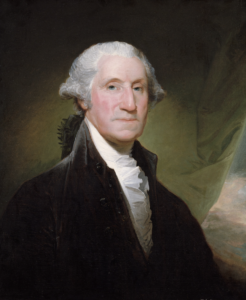 of the armies. The former President was weary. The light breeze kept the flies and mosquitos away from the East veranda and George and Martha sat there enjoying the boats sailing by on the slowly rolling Potomac River. The back door, its hinges in need of grease, squealed as Daniel, the house man, brought out some luscious ice cream in tiny porcelain cups for the enjoyment of the couple. Washington, months before, hauled the ice from the frozen Potomac and stored it in the ice house halfway to the river banks. He and Martha loved ice cream and he typically would prepare the delicacy himself, but he was tired and Daniel did it today. The ice was almost completely gone but winter was just months away and then Washington would replenish it.
of the armies. The former President was weary. The light breeze kept the flies and mosquitos away from the East veranda and George and Martha sat there enjoying the boats sailing by on the slowly rolling Potomac River. The back door, its hinges in need of grease, squealed as Daniel, the house man, brought out some luscious ice cream in tiny porcelain cups for the enjoyment of the couple. Washington, months before, hauled the ice from the frozen Potomac and stored it in the ice house halfway to the river banks. He and Martha loved ice cream and he typically would prepare the delicacy himself, but he was tired and Daniel did it today. The ice was almost completely gone but winter was just months away and then Washington would replenish it.
What?
Wait!
George and Martha Washington had ice cream? How can that be?
The story begins …
A couple of weeks ago Kate and I went out to dinner with some friends. The restaurant was almost unbearably noisy—as so many restaurants are—and conversation was difficult. The food was quite good, but we will never go there again.
I’m not sure what prompted one of us, shouting above the deafening din, to ask: “What’s your favorite food?” This question has come up periodically over the years and I usually mumble something like “sweet potato” or “broccoli” or “swordfish” or ”pastrami,” although those responses, and others, always felt puny and forced and, even as I said them, I knew they were not accurate. There was always the feeling of unintentionally missing the mark, the real “favorite.”
This time, I thought about it for quite a while before responding, and then, satisfied for the first time that I was answering correctly, I said, “Ice cream.” As soon as I said the words, I realized, at least for me, it was unequivocally true and, further, that the reason I had conjured up other answers in the past might have been because of some misguided idea that saying “ice cream” might seem trivial or silly or, worse, immature. Perhaps socially unacceptable. A dessert can’t be a favorite food. I suppose I never thought of desserts as food. Eggs are food. Spinach is food. Chicken is food. But dessert?
But it’s true—ice cream is the thing I most enjoy eating.
I have loved ice cream for almost as long as I can remember. In my fifth year as an octogenarian, ice cream is unequivocally my favorite food and always has been. I can do without ice cream for weeks at a time (or maybe it just seems that way after a few days of deprivation) but I often think about ice cream when I don’t have it. Some days I have the equivalent of a scoop or two (when I indulge myself with more than one scoop I borrow from the great 1960s/1970s comedian Flip Wilson and whisper to myself: “the devil made me do it”).
I don’t think about lamb chops or flounder.
Ever.
Getting ‘hooked.’
I have eaten ice cream from about the time I was eating solid food or perhaps even before that (my grandparents had what was then called a “candy store” at 324 Church Avenue, in Brooklyn. Many other things were more prominently sold than candy: newspapers, sodas, coffee, cigarettes and cigars, magazines and comic books, children’s toys as well as easily accessible ice cream). Newspapers were the most prominent item, with huge stacks of the Daily News, the Mirror, the New York Times, the Herald-Tribune, the Journal-American, the New York Post and the Brooklyn Eagle (founded in 1841 and once edited by Walt Whitman). That little store was the first place to buy a newspaper between Ocean Parkway, lined by giant apartment buildings, and McDonald Avenue, six blocks away.
My first ice cream memory, however, is from 1944 when I was five years old and my tonsils were removed. Tonsillectomy was a relatively common operation in those days, in contrast to today when it is uncommonly performed. Generally, the indication for tonsillectomy in those pre-penicillin years, was repeated, annual, upper respiratory infections. Four years in a row and the tonsils were supposed to come out. I doubt if there was established science behind that policy. I certainly don’t recall if I had the requisite four years. I think it was generally a pragmatic decision, based mostly on a pediatrician’s past experience and definitely without carefully performed and controlled clinical studies.
The tonsils play an important role in the immune system. They are at the back of the throat and are one component of the ring of lymphoid tissues (Waldeyer ring) which include lingual tonsils, at the back of the tongue, pharyngeal tonsils (or adenoids) at the back of the nasal cavity, tubal tonsils, at the roof of the pharynx, and palatine tonsils, the formal name of what we think of as “tonsils.” The (palatine) tonsils can be seen (if they haven’t been removed) on each side at the back of the opened mouth, easier to see in younger people. Tonsillar tissues reach their largest size at puberty and gradually undergo atrophy after that. Adenoids can be almost unidentifiable by adulthood.
The tonsils produce antibodies in response to antigens of various pathogens. Tonsils can respond to those pathogens by becoming visibly enlarged with proliferation of the antibody-producing lymphoid tissue (“adenotonsillar hyperplasia”) as well as by being inflamed (“tonsillitis”). There is much more to say about tonsils but that is not the purpose of this blog, except to note that antibiotics have made the removal of tonsils and adenoids (tonsillectomy and adenoidectomy) an almost-never-performed operation.
Tonsillectomy is a relatively simple surgical procedure with almost no mortality and with little morbidity (sickness) except for intense, burning pain at the surgical site. In 1944 we didn’t have cherry-flavored liquid aspirin or, for that matter, any common medications formulated specifically for children. Standard adult aspirin would be cut in half, crushed and mixed with apple sauce. I suppose I got some of that but the only thing I remember was the pediatrician’s recommendation that I have as much ice cream as I wanted to soothe my traumatized throat.
That is where, when, why and how my addiction developed.
The beginnings of ice cream
Ice cream has been around a long time. There is evidence that an ice desert began in ancient Iran, Persia, around 500 BCE. Flavors added to ice produced summertime treats for royalty, but I am not sure I would consider that as ice cream. The rose water ice they made might be mixed with saffron, fruits and various flavors. But this almost certainly was equivalent to sorbet, rather than the sweetened frozen food we make from dairy cream or milk. In this sense, so-called “Italian ice,” where syrups of various flavors are dripped on shavings or chips of ice is akin to sherbet. At about this same period, the ancient Greeks ate snow mixed with honey and fruit. Alexander the Great (356-326 BCE) apparently enjoyed iced beverages.
It wasn’t until approximately 200 BCE when a frozen mixture of milk and rice was created in China. Freezing was obtained by placing a vessel of this preparation, to which sweet syrups might be added, in a container filled with snow and saltpeter, which brought the temperature to freezing. Later, during the Tang dynasty (618-907) a preparation resembling modern ice cream consisted of goat, buffalo or cow milk with flour and camphor from evergreen trees, made creamy after being plunged into ice pools.
Nero (37-68 CE) had ice brought from the mountains close to Rome and added fruit toppings to create a delicious, chilled food but icy treats reminiscent of ice cream were not popular in Europe until Marco Polo (1254-1324) brought stories from the Far East of the delicacies.
In the 16th century, fruit sorbets were created in Delhi, India, by using a series of horsemen as relays to bring ice from mountains to the city. One of the popular frozen dairy dishes still used today in India, qulfi, has been referred to as “traditional South Asia ice cream, originating in the Mughal Empire and probably derived from a Persian ice cream.”
Myths have arisen about the introduction of ice desserts to Europe. Catherine de’ Medici (1519-1589) may have brought chefs skilled in creating flavored sorbets to Italy when she married Henry II (1519-1559) of France. A century later, it was rumored that Charles I (1600-1649) of England gave his personal ice cream maker, a Frenchman, a lifetime pension to keep the formula secret so that only the King and his family could enjoy “frozen snow.” Although there are a couple of home-made ice cream shops in Cromwell, Connecticut, there is no evidence that the humorless Oliver Cromwell (1599-1658) maintained the position of royal ice cream maker after he lopped off Charles’ head in a public execution in front to Banqueting House at the Palace of Whitehall. Soon after the restoration of the crown, Charles II (1630-1685), publicly enjoyed ice cream, something he learned to love during his exile in France and which became widely enjoyed during the early years of his reign.
In the 17th century recipes for frozen ices appeared in French and Italian publications and, by 1718, the recipe for ice cream described a method not too much different from the way ice cream is made today. Other cookbooks in the 18th century refined the method.
The first reference to ice cream in North America was in 1744, perhaps introduced by the early Quakers. The guests at a dinner in Maryland’s governor’s home were served dessert with “fine ice cream.” It was well known that George Washington (1732-1799), Thomas Jefferson (1743-1826) and Benjamin Franklin (1705-1790), among others, regularly ate ice cream and served it to their guests. In the summer of 1790, Washington spent approximately $200 (approximately $6600 in today’s currency) on ice cream. Jefferson, ever the inventor, appears to have developed an 18-step recipe for ice cream. In 1813, at James Madison’s (1751-1836) first inaugural ball,
Dolley Madison (1768-1849) served ice cream. Mrs. Madison apparently learned the recipe after traveling to see Sallie Shadd, a freed slave, who started a catering company in Wilmington, Delaware, and featured ice treats made with sugar, cream and fruit. Presidential campaigns require a candidate to be photographed eating pizza, hot dogs, various ethnic foods (depending on the neighborhood) and, certainly, ice cream.
Augustus Jackson (1808-1852), another African-American, was a White House chef. After leaving the White House in the 1820s he moved to Philadelphia where he created a highly successful catering business and became known as the “father of ice cream” after developing methods to add salt to the water used to freeze the cream. He also perfected the egg-free “Philadelphia-style” ice cream that remains the most popular in American to this day. The first patent for a hand-cranked ice cream cooler was awarded in 1843 to Nancy Johnson (1794-1894), also in Philadelphia. A prolific inventor, in addition to being a teacher and missionary. Johnson’s device revolutionized the ice cream industry making it possible to make and sell ice cream on a large scale.
In England, small ice cream freezers were invented by Agnes Marshall (1852-1905), who was referred to as the “queen of ices’ and who also devised the first edible ice cream cone from biscuits. Marshall was particularly known for her work on ice cream and frozen desserts. Among the books she wrote were The Book of Ices and Fancy Ices.
Ice cream has been prominent in films, including the marvelously charming Roman Holiday with Audrey Hepburn and Gregory Peck and also Forrest Gump starring Tom Hanks.
The bag of gold, silver, and bronze jangling cheerfully in Harry’s pocket was clamoring to be spent, so he bought three large strawberry-and-peanut-butter ice creams which they slurped happily as they wandered up the alley, examining the fascinating show windows. -Harry Potter and the Chamber of Secrets, J.K. Rowling
The number of flavors of ice cream is almost limitless, and, if you are in the right city, you can sample octopus, shrimp, horseflesh and cow-tongue ice creams, alongside vegetarian choices including kelp and soybean.
The ice cream cone
It is not entirely clear how and when the ice cream cone was invented but it was almost certainly in the late 18th century. In 1901, an Italian citizen living in Manchester England, Antonio Valvona, filed a patent for an “apparatus for baking biscuit cups for ice cream.” An Italian American living in New York City, Italo Marchiony, who partnered with Valvona, was granted the first American patent in 1903 for inventing an ice cream cone. They founded the Valvona-Marchiony company which produced the patented cups. In most articles, credit is given to Ernest Hamwi. During the 1904 St. Louis World’s Fair a Syrian waffle-maker, Ernest E. Hamwi (1883-1943) had a booth next to an ice-cream seller who, it is said, ran short of dishes. Hamwi rolled a waffle to hold his ice cream and the modern ice cream cone was born. The story is complicated by this photograph of Mrs. Montague Lyon and her children, at the same St. Louis World’s Fair eating ice cream from a cone unlike those of Valvona, Marchiony and Ham, but there are no details about where she purchased them.
There’s much more to the ice cream story if we discuss the variants, such as gelato, which contains more milk than cream, making it freeze at a lower temperature and yielding a lighter, cooler and, for many, more delicious treat. Gelato is typically churned at a slower rate than ice-cream and is denser with a more intense flavor. There are tales of how ice cream sundaes were named in response to religious restrictions, how ice cream sandwiches vary from country to country and how Mussolini banned ice cream through Italy in 1943 because it was “too American.” We could spend much more time discussing the history of ice cream, or how ice was ‘harvested’ from great rivers in cities around the world, how different styles of ice cream evolved, and more. In addition to cones, we could ay a little about the history of sherbet, ice cream pops, ice cream sandwiches, ice cream cakes, soft ice cream, and on and on and on.
Ice cream in my old neighborhood
When I was a child, one of the most exciting events was the ringing of the bell on the Good Humor truck. Choices were few in those days—vanilla, chocolate and strawberry and either a cup of on a stick (an ice cream “bar”)—and, as I recall, the flavor of the ice cream was far from that of today’s ice creams but, still, they were so good. Vanilla ice cream covered with a veneer of chocolate. The trick was to bite into the chocolate and not have it fracture and fall to the ground or on your shirt. The Good Humor truck doesn’t come to my new neighborhood and when I look at the webpage (of course Good Humor has a webpage!) they still offer that original bar along with more complex concoctions. The Good Humor trucks were phased out in the 1970s. In 2014, the company launched the first commercially viable solar-powered freezers in some of New York’s parks; I have not encountered one yet but, if I do, I will definitely try that ice cream treat I once enjoyed so much.
Ice cream in my new neighborhood
It was only with great difficulty that I would pass a gelato shop but I generally had less trouble declining regular ice cream when it was offered in a store (except in the United Kingdom where I especially enjoy the packaged ice cream cones). That changed in the last few months.
For years, when, after a morning walk with our daughter, Jennifer, and her dog, Kinder, in the north part of Central Park (only a few people know about this part of Central Park. It’s shut off from the hustle and bustle of the city; a peaceful woodland that makes you think you are back in the 18th century. It is also an important bird sanctuary) I would take the 2nd Avenue bus to return to our former apartment on East 49th Street. The bus would pass Anita’s Gelato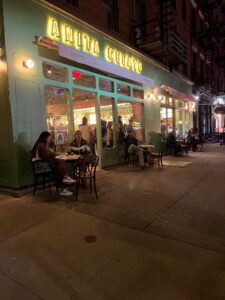 on the corner of East 81st Street and 2nd Avenue. There is almost always a very long line to get into Anita’s, even in cold weather, reminiscent of the line usually found at Bertillon on the ïle St. Louis in Paris, but I never got off the bus (even my addiction has limits and I can’t eat ice cream, candy, and other sweets before noon) to try some of the flavors. We now live on the upper east side (UES) of Manhattan, on East End Avenue and East 81st Street, where I find myself just three blocks away from Anita’s. Even when it is chilly jacket weather, there are a few people sitting outside and a long line at the counter. More than once I thought how lucky I am as we sat at one of the outside tables enjoying their luscious gelato. Every now and then, we brought some home in their special insulated boxes.
on the corner of East 81st Street and 2nd Avenue. There is almost always a very long line to get into Anita’s, even in cold weather, reminiscent of the line usually found at Bertillon on the ïle St. Louis in Paris, but I never got off the bus (even my addiction has limits and I can’t eat ice cream, candy, and other sweets before noon) to try some of the flavors. We now live on the upper east side (UES) of Manhattan, on East End Avenue and East 81st Street, where I find myself just three blocks away from Anita’s. Even when it is chilly jacket weather, there are a few people sitting outside and a long line at the counter. More than once I thought how lucky I am as we sat at one of the outside tables enjoying their luscious gelato. Every now and then, we brought some home in their special insulated boxes.
As a part of being in a new neighborhood we have also been exploring the restaurants. About three months ago we tried a little French restaurant, Moulin, on York Avenue and East 77th. The restaurant was quite good but, as we left, I noticed a small ice cream store, Dubl Twister, a few doors away. The sign also says: “Family Owned and Handcrafted Ice Cream and Coffee Shop since 1973.” Of course, we tried it. Suffice it to say, I have not been to Anita’s, or the even closer Emack & Bolios, since finding this place. When the elementary school across the street from Dubl Twister lets out at 3 PM it’s crowded, otherwise it is just a short wait until you get to taste the best ice cream I have ever had.
If you are a chocolate lover, the “Chocolate Madness” will bring a broad smile to your face and that special euphoria that leads to worries about overdosing. “Coffee,” Strawberry,” “Mint Chocolate Chip.” “Vanilla Chocolate Chip,” even plain vanilla, are also luscious. I haven’t tried the fancier concoctions with Oreos or nuts or whatever.
I am fortunate, mostly because of genes inherited from long-lived ancestors, to have relatively clean coronary arteries, as seen with both calcium scans (a specialized computerized tomography—CT—scan that looks for calcification in the coronary arteries) as well as by angiography (dye directly injected into the openings of the coronary arteries and then visualized with standard x-rays). Calcification is a reliable sign of coronary artery atherosclerosis which, when pronounced, causes narrowing of the coronary arteries and resultant loss of oxygenation of the heart with resultant pain (“angina pectoris”) and, usually, death of heart cells (“myocardial infarction”). It is, needless to say, gratifying to know my coronaries are in better shape than most people my age although, of course, that is not a guarantee of anything. There are other risk factors that contribute to injuring heart cells, including hypercholesterolemia (high levels of lipids in the blood) and hypertension (elevated blood pressure). I have both and take medications for both which keep the values in healthy ranges.
The only time I think about all this medical/pathologic information is when I, every now and then, have more than two scoops of ice cream or a deliciously buttery croissant (a marvelous French bakery is three blocks away, on 82nd Street) or some other fat-full food. I sometimes have a mini-delusion about an express tube that carries dangerous cholesterols directly from my tongue to my coronaries. At those moments I hope that my statin medication (the medicine I take to block the absorption of those evil lipids) is earning the faith I place in it. (As if to mitigate my anxieties, an article in the food section of the July 31, 2023 New Yorker is entitled “Ice Cream Is Good for You,” based on an April 13,2023 article (“Nutrition Science’s Most Preposterous Result”) in The Atlanticmagazine, which followed a series of articles in scientific journals from Harvard Medical School’s Department of Nutrition).
Is there a cure for ice-cream addiction?
I hope not.

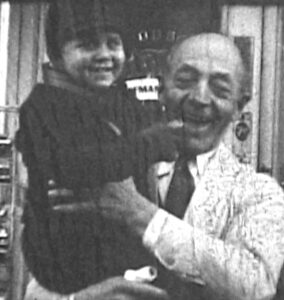
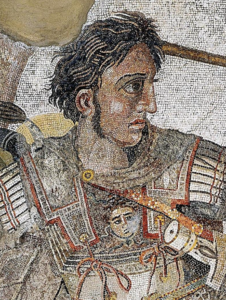
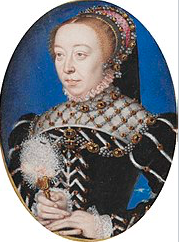
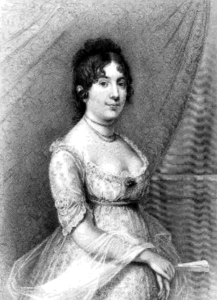
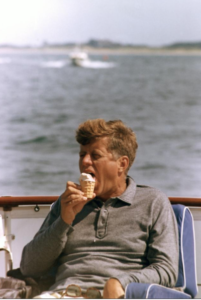
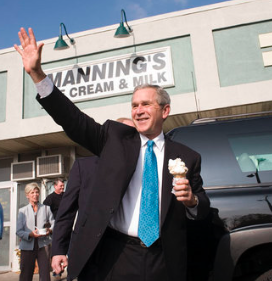
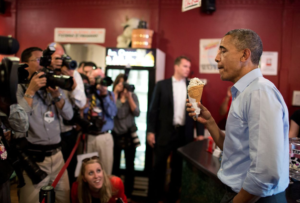


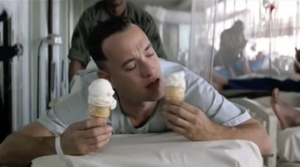
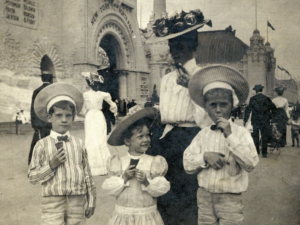
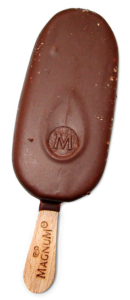
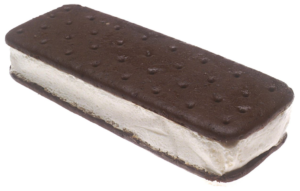
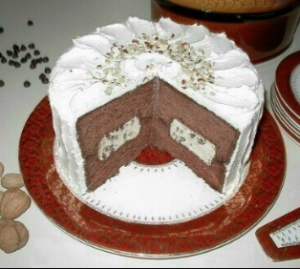
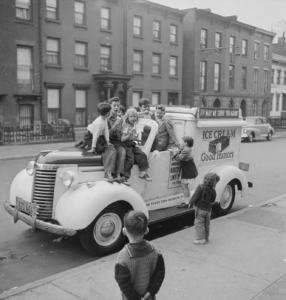
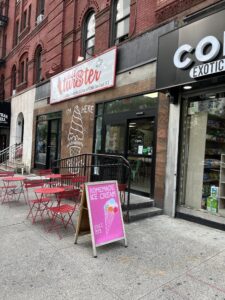
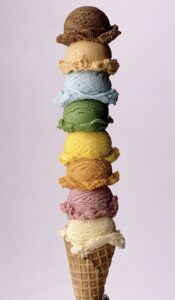
December 3, 2023 at 9:41 pm
My current favorite is Tillamook Mudslide with Turkey Hill Triple Chocolate a close second.
December 4, 2023 at 1:42 am
I was so happy when Salt and Straw opened in Culver City.
December 4, 2023 at 9:59 am
I recall (unreliably, perhaps) our neighborhood Good Humor Truck also had a vanilla bar for which the chocolate coating had small pieces of chopped nuts.
But much more important is to point a Brooklyn boy like you to Jeni’s (jenis.com) Blackout Cake. I’ve made the cake and had the ice cream — I’m sure the Ebinger family would love the ice cream (not sure how they’d react to my cake, however).
December 4, 2023 at 12:18 pm
Non una parole su gelato🍨 ?
December 4, 2023 at 12:20 pm
“Parola”
Blame SpellCheck.
December 4, 2023 at 2:02 pm
My all time favorite is still Vanilla, boring right?
December 4, 2023 at 6:27 pm
Thanks, my dear old friend for bringing me back to Brooklyn and 16th street. Remembering your grandmothers candy store on Church Avenue (where my brother worked for a short time). And I too still love ICE CREAM but I need to drive to get a cone I am about 14 mile from the nearest store.
December 4, 2023 at 6:49 pm
Al,
Perfect. More than a mile means you need to buy it by the gallon and put it in your freezer!
I remember Carmine, Jr. and Tootie and your parents so well. They were family for me, also.
Hope you are managing well and hope our paths manage to cross again in the not-too-distant future.
December 5, 2023 at 3:23 pm
Wonderful story.
One addition. I am absolutely sure your grandfathers “candy store” on Church street carried all the newspapers you describe along with the local favorite, The Forward!
April 15, 2025 at 12:15 pm
Definitely carried the Forward, and also the a number of European-language newspapers (German and others).
January 17, 2024 at 4:13 pm
I thorough enjoyed your short novel on the millennia history of ice cream. Since I am your older cousin by 2 years and grew up for most of our early life just 8 blocks from your family it was a walk down memory lane.
I especially enjoyed the mention of your maternal Grandfather and his Church Ave. candy store. My grade school PS179 was just 3 blocks away so me and my homies would spend our Pennie’s n nickels there.
Also, at the age of 9 my Aunt Alice, coincidentally your Mother , went across Church Ave and got me my first paying job for the Kosher Meat Mkt that summer delivering meat in the neighborhood on my new blue n white Schwinn bicycle.
My Dad, your Uncle Joe was also a Milk Truck delivery man for Borden’s Dairies n his territory was Downtown Manhattan, so our freezer was always stocked with Chooolate n Vanilla Ice Cream n U-Bets syrups.
You forgot to mention your Grandfather made the best Egg Creams in Flatbush!